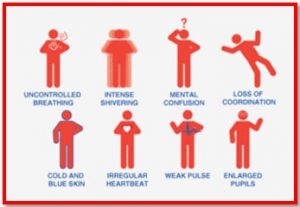HYPOTHERMIA
HYPOTHERMIA
Hypothermia is a condition of reduced general body temperature, which occurs when the body loses more heat than it can produce. Body temperature drops below 35 degrees Hypothermia is most common during cold weather or when immersed in cold water, it is also caused by strong cold air currents, but can also develop in warm weather, when a person lies motionless on a cold surface (eg alcohol or drug intoxication, trauma, stroke). or after a very long stay in water that is suitable for swimming temperatures (e.g. 20-24 ° C). Newborns and young children are prone to hypothermia due to low body weight.
Symptoms and signs of hypothermia
At the beginning, the person has a feeling of coldness and trembling (this stage may be absent, but trembling is a good sign because it is an indicator that the thermoregulatory system is still active). Later the feeling of coldness ceases, fatigue, drowsiness, exhaustion, loss of coordination, difficulty speaking occur. All bodily and mental functions are slowed down. With further lowering of the body temperature the person loses consciousness. Breathing and heart rate slow down greatly. If no help is provided, death occurs due to cessation of breathing and heartbeat.

Mild hypothermia (36-35 ° C)
⦁ Shivering
⦁ Dizziness
⦁ Hunger
⦁ Nausea
⦁ Fast breathing
⦁ Speech difficulties
⦁ Slight confusion
⦁ Lack of coordination
⦁ Fatigue
⦁ Increased heart rate
Umjerena (35-33° C) do teške pothlađenosti (<33-28 ° C)
⦁ Shivering, though, as hypothermia worsens - shivering stops
⦁ Clumsiness and lack of coordination
⦁ Difficulty speaking and muttering
⦁ Confusion
⦁ Drowsiness and low energy
⦁ Progressive loss of consciousness
⦁ Weak pulse
⦁ Slow, very shallow breathing
⦁ The skin becomes pale
Signs and symptoms of hypothermia
Signs of hypothermia in infants
Cold babies may look healthy but have:
⦁ Very red, cold skin
⦁ Very low energy, they are quiet, weak crying (screaming)
⦁ They refuse food
Treatment of hypothermia
Hypothermia is a potentially life-threatening condition that requires urgent medical attention. The priority is to prevent further heat loss. Procedures performed in the treatment of hypothermia must be gradual, because sudden warming could lead to a sudden dilation of blood vessels on the surface of the body, and cause a rush of blood to the periphery, which would lead to a lack of it in vital organs. Also, the procedures performed during treatment depend on the state of consciousness of the victim.
Conscious hypothermic persons should be brought indoors if possible, wet clothes and footwear should be replaced with dry ones. Minimize larger movements and movements (active movements, such as walking or larger manipulations of the extremities, are allowed only in mild hypothermia). Outdoors, the injured should be protected from the wind and insulated from the ground by placing them on a dry mat. Lay the person on spread blankets, place aluminum foil or plastic under the body. Soak sheets or towels in warm water (not warmer than 70 ° C) and place them on the chest, abdomen and groin of the hypothermia and wrap with foil, omitting hands when wrapping. After all, wrap the whole body with blankets so that only the face remains exposed (Hibler's thermal envelope). Heat sources (hot water bottle, radiators and flames) must not be placed directly near a hypothermic person due to the risk of burns as well as excessive acceleration of blood circulation which could turn instead into the heart and brain into the skin and periphery. In mild hypothermia where the swallowing reflex is preserved, it is allowed to avoid giving warm sweetened beverages as well as more caloric foods (chocolate), alcoholic beverages.
It is necessary to constantly monitor and control vital signs (breathing, level of consciousness, pulse and body temperature)
In the case of a hypothermic unconscious person, check pulse and respiration and initiate resuscitation measures if necessary. In a hypothermic state, breathing and heart rate can be so weakened and slowed that they can be overlooked. Detecting a pulse in a patient with hypothermia can be difficult, so signs of life and pulse should be carefully checked for a full sixty seconds. Persons without a pulse should start cardiopulmonary resuscitation (CPR) immediately. When resuscitating a hypothermia person needs to be more persistent than usual, there are many reports that survival occurs even with prolonged CPR. For hypothermic people, the rule is that "no one is dead until they are warm and dead" - basically means that patients must not be considered dead before warming up is provided.
